Overview
Mastering functional core stability exercises is essential for improving overall strength, balance, and injury prevention across all fitness levels. The article emphasizes that these exercises not only enhance athletic performance but also facilitate everyday activities by strengthening the core muscles, supported by research demonstrating significant improvements in balance and functional capabilities among participants.
Introduction
In a world where physical demands are constantly evolving, the importance of core stability cannot be overstated. This often-overlooked aspect of fitness serves as the bedrock for functional movement, playing a pivotal role not only in athletic performance but also in everyday activities. By understanding and prioritizing core training, organizations can empower their teams to enhance balance, prevent injuries, and improve overall well-being.
As research continues to reveal the profound benefits of a strong core, the time has come for HR Benefits Managers to champion these exercises within their wellness initiatives, transforming the health landscape of their workplaces and fostering a culture of vitality and resilience.
Understanding Core Stability: The Foundation of Functional Exercises
Core strength is the harmonious function of the muscles in your abdomen, lower back, hips, and pelvis, working together to support the spine. Building a solid foundation is essential for sustaining balance, support, and enabling functional core stability exercises for efficient movement. Studies indicate that fundamental exercise has a notable effect on balance, with a standardized mean difference of 0.81 (95% CI: 0.34–1.27; p = 0.0006), demonstrating considerable advancements in comparison to control groups.
This foundation is not just essential for enhancing athletic performance; it also plays a crucial role in everyday activities like standing, walking, and lifting, which can be improved through functional core stability exercises. By incorporating functional core stability exercises, you can enhance your posture, improve your physical abilities, and reduce the risk of injuries. As illustrated in the research by Park, Hyun, and Jee (2016), archery athletes who participated in a structured abdominal conditioning program showed significant advancements in balance, emphasizing the practical advantages of abdominal exercises.
Additionally, Thomas Weber mentions,
In conclusion, this is the first study to compare the development of central support, athletic performance, and injury risk throughout a full season of high-level soccer (2024).
This highlights the significance of including functional core stability exercises in your routine, as they are essential not only for athletic performance but also for improving daily functioning and overall health. Grasping the principles of your center enables you to participate in more efficient functional activities, leading to a thorough fitness journey that enhances longevity and vitality.
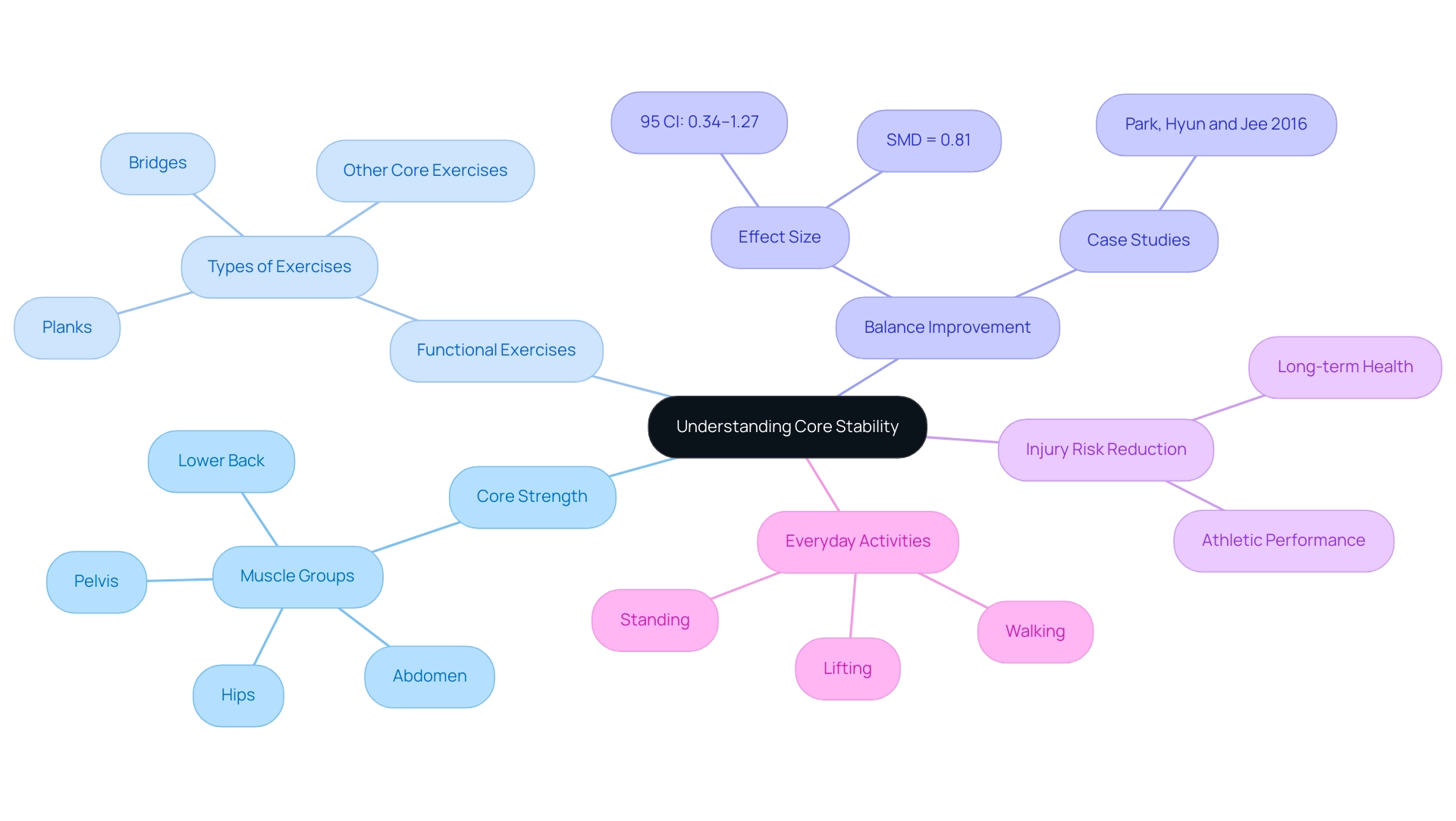
Essential Functional Core Exercises for All Fitness Levels
- Plank: This fundamental workout is crucial for engaging multiple muscle groups and is an essential example of functional core stability exercises that enhance stability and strength. Aim to hold the position for 30 seconds to 1 minute, gradually increasing your duration as your strength improves. Research by McGill & Marshall (2012) confirms the effectiveness of functional core stability exercises for individuals aged 25.60 ± 3.40 years, making these exercises a relevant practice for many in the workplace. Our app-based coaching ensures that your team receives personalized guidance to master this fundamental movement, tracking progress and providing feedback.
- Bird-Dog: Start on all fours, extending one arm and the opposite leg while keeping a firm torso. Hold this position for a few seconds before switching sides, promoting balance and coordination. As part of our wellness workshops, we provide structured sessions that help employees develop this skill effectively, integrating it into our corporate membership offerings, which include in-person wellness talks.
- Dead Bug: Lie on your back with arms and legs elevated. Lower one arm and the opposite leg while maintaining your abdominal muscles engaged for 10-15 repetitions. This activity includes functional core stability exercises that improve stability and coordination, which are essential for everyday tasks and overall well-being. With our tailored programs, we help individuals track their progress through our health and wellness app, which also offers nutrition guidance as part of our corporate memberships.
- Russian Twists: Sit on the floor with your knees bent and lean back slightly. Twist your torso to touch the floor beside you, performing 10-15 repetitions on each side. This dynamic movement builds rotational strength and flexibility, crucial for preventing injuries. Integrating these activities into corporate wellness programs, alongside our nutrition services, fosters a culture of health and fitness.
- Glute Bridge: Lying on your back with knees bent, lift your hips towards the ceiling while squeezing your glutes. Hold for 3 seconds before lowering back down. Repeat for 10-15 reps to strengthen your posterior chain. Each activity can be customized for novices or experienced individuals, ensuring everyone gains from foundational strengthening. Although the clinical advantages of fundamental strength routines have been shown in the short term, the long-term impacts are still uncertain. By incorporating functional core stability exercises into your team's wellness programs, you are paving the way for enhanced balance, flexibility, and overall strength. A case study by Hlaing et al. discovered that individuals participating in stability routines exhibited notable advancements in proprioception, balance, and muscle thickness, reinforcing the significance of these activities in workplace wellness programs. Our app not only supports these exercises but also connects employees with a community, enhancing their overall wellness journey.
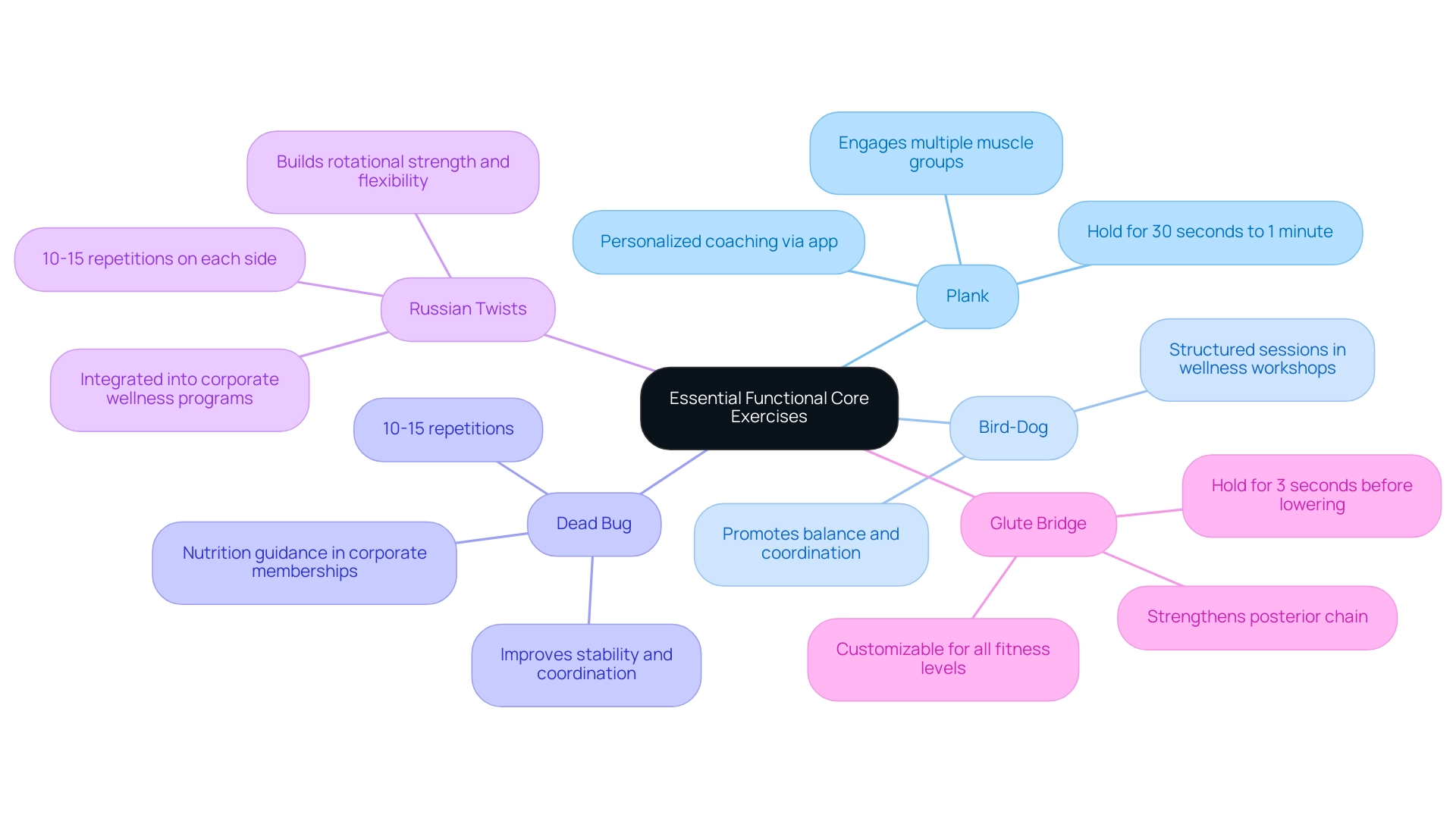
Progressive Approaches to Core Training: Building Strength Safely
To effectively cultivate foundational strength, it’s essential to adopt a gradual approach that prioritizes safety and efficacy. Considering that 34% of employees skim through compliance information, clear communication in educational programs is vital. Here’s a recommended progression to guide your team through core training:
- Begin with Isometric Holds: Initiate the journey with foundational movements like planks and bridges. These functional core stability exercises are excellent for building both endurance and stability.
- Introduce Dynamic Movements: As confidence increases, incorporate dynamic activities such as bird-dogs and Russian twists. These movements not only enhance strength but also improve coordination.
- Incorporate Resistance: To elevate the challenge, introduce resistance bands or weights. This step is crucial for stimulating muscle engagement and promoting growth. Research has indicated that free-weight movements provoke significant muscle activity, particularly in the rectus abdominis and external oblique muscles.
- Vary Angles and Positions: Experimenting with stability balls or balance boards can broaden the exercise experience, engaging central muscles from various angles and improving overall equilibrium.
- Add Functional Movements: Finally, integrate exercises like kettlebell swings or medicine ball throws. These dynamic movements incorporate functional core stability exercises, utilizing stability in real-life situations and reinforcing muscle memory and functional strength.
As echoed by Corporate Compliance Insights, effective development strategies are essential for engagement. By advancing at a comfortable pace, your team can avoid injuries while ensuring sustainable outcomes in strength. The significance of this methodical approach cannot be overstated, particularly since studies indicate a significant emphasis on muscle activity in progressive techniques.
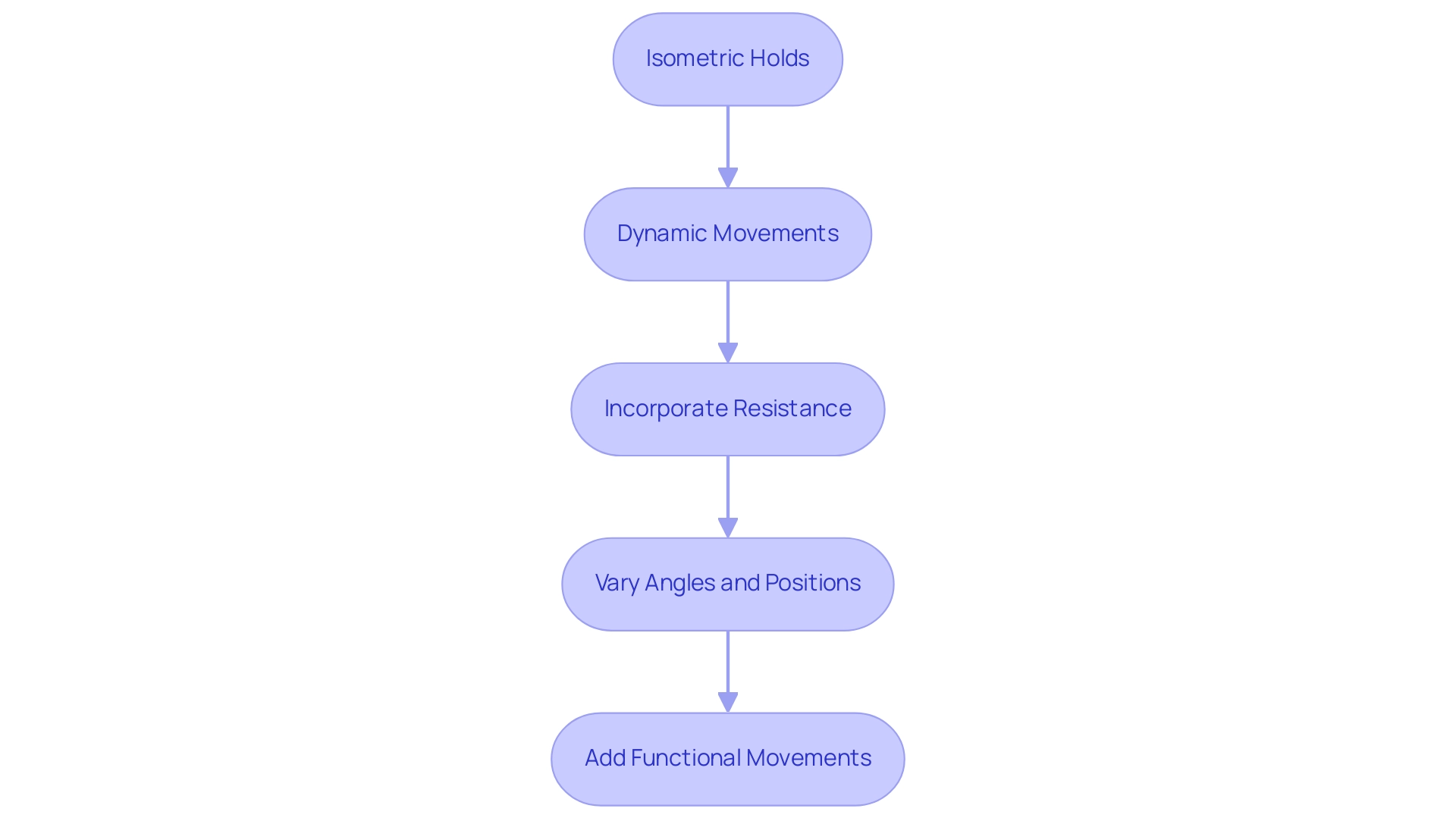
Avoiding Common Mistakes in Core Stability Training
- Neglecting Form: Proper form is the foundation of effective functional core stability exercises. Focusing on quantity over quality can lead to injuries that hinder progress. As Jean-Jacques Orban de Xivry highlights, 'understanding movement control is essential for maximizing benefits and preventing injuries.' This aligns with the importance of proper analysis in training effectiveness, as mixing within- and between-analysis units can create dependencies that lead to incorrect interpretations of performance outcomes.
- Rushing Through Reps: Engaging your core effectively requires patience. Slow, controlled movements, as seen in functional core stability exercises, not only enhance muscle engagement but also reduce the risk of injury. Recent findings emphasize that taking your time leads to significant improvements in strength and stability, reinforcing the importance of proper form and technique.
- Ignoring Breathing: Consistent and steady breathing throughout exercises is crucial. Holding your breath can create unnecessary tension, compromising your form and effectiveness. A steady breathing pattern helps maintain focus and ensures that your center is properly engaged, which is vital for performing functional core stability exercises and preventing injuries.
- Overtraining: Recovery is as important as the workouts themselves. Allowing adequate recovery time between sessions is essential to prevent muscle fatigue and injuries. Overworking can result in reduced returns, making rest a key element of any effective exercise regimen. Statistics show that injury rates related to poor core training form can significantly increase when proper recovery is neglected.
- Lack of Variety: Incorporating a diverse range of exercises keeps your routine fresh and targets various muscle groups. This variation not only boosts engagement but also adds to overall balance and strength. Adaptability in your exercise method assists in evading typical errors and fosters a more comprehensive fitness experience.
By identifying and tackling these frequent missteps, you can greatly improve the efficacy of your regimen by incorporating functional core stability exercises, laying the foundation for enhanced health and performance. Utilizing standardized analytic approaches and pre-registration of designs can also help in preventing issues related to p-hacking, ensuring the integrity of your training results.
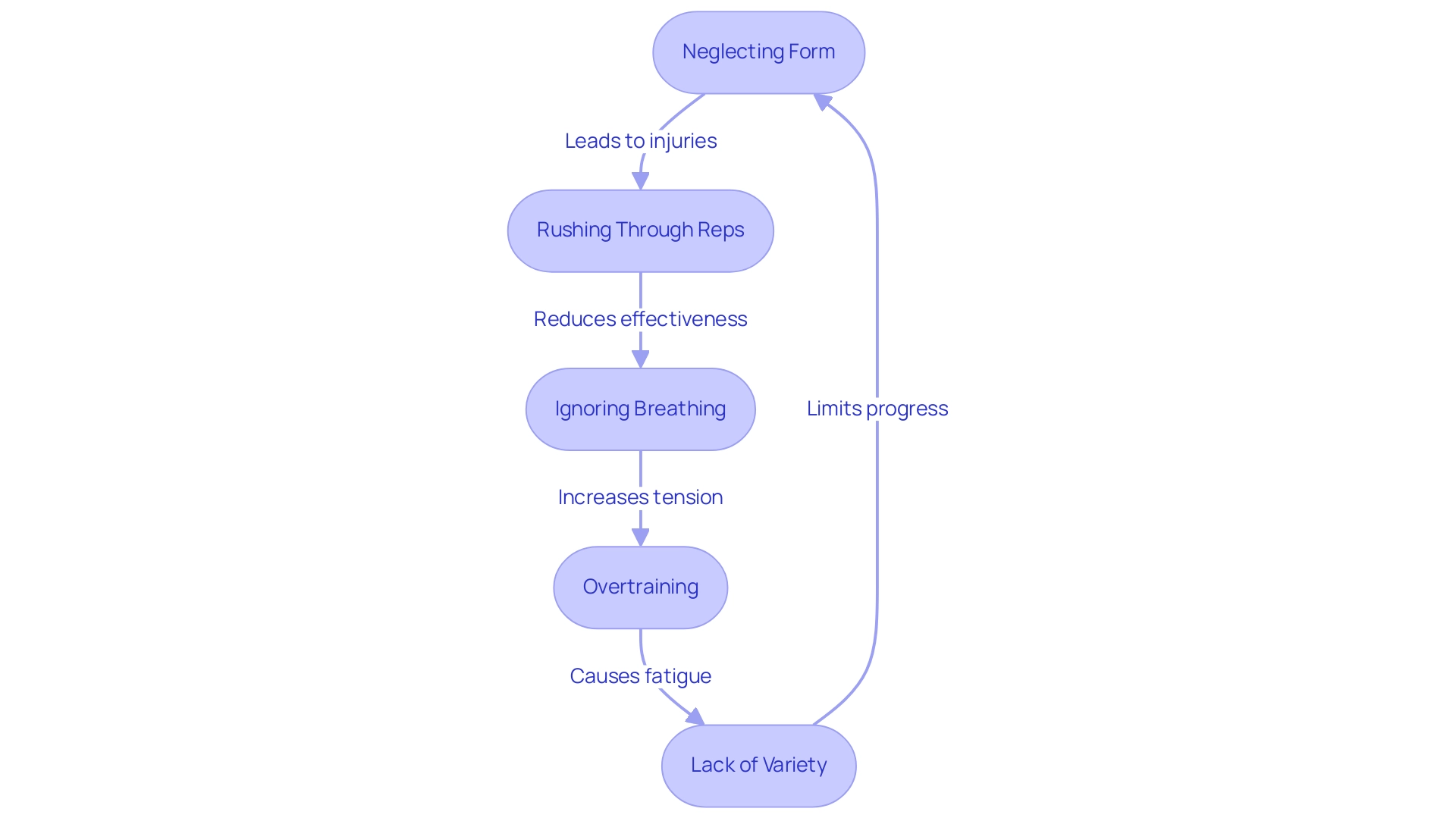
The Broader Benefits of Core Stability: Enhancing Performance and Daily Life
The benefits of functional core stability exercises extend far beyond mere physical fitness, significantly impacting athletic performance and daily activities. Key advantages include:
-
Improved Posture: A strong center plays a pivotal role in maintaining proper alignment, which helps reduce strain on the back and enhances overall body mechanics.
-
Enhanced Athletic Performance: Core strength is fundamental in sports, as it directly contributes to balance, coordination, and power generation. Recent research indicates that after implementing functional core stability exercises, the peak strike velocity in athletes increased from 6.7 ± 0.7 m/s to 8.8 ± 0.9 m/s, demonstrating the critical role of stability in athletic contexts.
-
Injury Prevention: With strong central muscles, the body is better stabilized during movement, which significantly lowers the likelihood of injuries. This protective aspect of functional core stability exercises is crucial for both athletes and active individuals.
-
Better Daily Functionality: Everyday activities—ranging from lifting and bending to sitting—become not only easier but also safer when abdominal strength is prioritized.
-
Increased Confidence: A strong foundation fosters enhanced self-esteem and body awareness, contributing positively to mental well-being. As Kuan Dong from Myongji University observed,
These results indicate that it is essential to properly design fundamental preparation programs to enhance sport-specific athletic performance.
It is advised that fundamental training be incorporated into routines at least twice a week for four weeks to maximize these benefits.
Moreover, findings from the case study titled 'Swing Leg Dynamics in Biped Systems' emphasize the significance of central strength in preserving balance during movement, suggesting that ideal step duration remains unchanged while the ideal step position is directly proportional to the magnitude of disturbances. This corresponds effectively with the perception that fundamental strength is essential for balance. Additionally, the findings of the study were registered with the INPLASY website and utilized PRISMA guidelines for data collection and analysis, enhancing the credibility of the research.
By incorporating functional core stability exercises into routines, individuals can significantly elevate their performance in both athletic pursuits and everyday tasks. Embracing these exercises not only fortifies physical capability but also cultivates a sense of empowerment and confidence among participants.
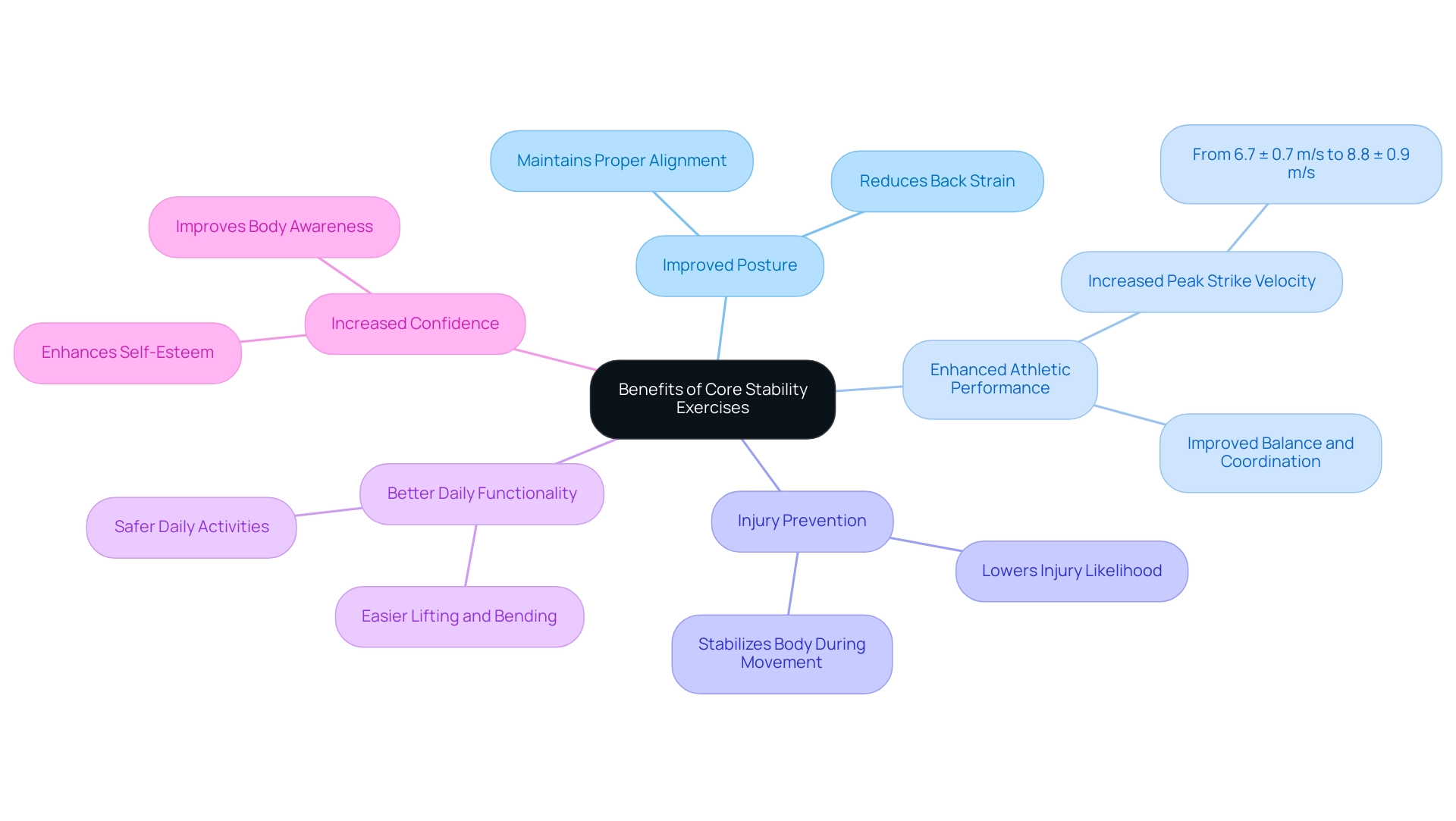
Conclusion
Core stability is an essential component of overall fitness that extends its benefits far beyond the gym. By understanding its significance, organizations can implement core training into their wellness initiatives, promoting improved balance, posture, and injury prevention among employees. Engaging in targeted exercises such as:
- Planks
- Bird-dogs
- Russian twists
equips individuals of all fitness levels with the tools to enhance their physical capabilities, leading to a more resilient workforce.
Moreover, adopting a progressive approach to core training ensures that employees build strength safely and effectively. By prioritizing form, pacing, and variety, organizations can mitigate common mistakes that hinder progress, ultimately fostering a culture of health and well-being. The ripple effect of improved core stability can transform not only athletic performance but also everyday functionality, empowering employees to navigate their daily tasks with confidence and ease.
Incorporating core stability exercises into workplace wellness programs is not just a trend; it is a vital strategy for enhancing the overall health landscape of an organization. By championing this approach, HR Benefits Managers can lead the charge towards a healthier, more active, and engaged workforce, setting the stage for long-term success and vitality in both professional and personal realms. Now is the time to embrace core training and unlock the full potential of every team member.
Frequently Asked Questions
What is core strength and why is it important?
Core strength refers to the harmonious function of the muscles in the abdomen, lower back, hips, and pelvis that support the spine. It is essential for sustaining balance, supporting functional movements, and enhancing athletic performance, as well as improving everyday activities such as standing, walking, and lifting.
How do functional core stability exercises benefit individuals?
Functional core stability exercises enhance posture, improve physical abilities, and reduce the risk of injuries. They are crucial for both athletic performance and daily functioning, contributing to overall health and fitness.
What evidence supports the effectiveness of core stability exercises?
Studies indicate that fundamental exercises significantly improve balance, with a standardized mean difference of 0.81, demonstrating notable advancements compared to control groups. Research by Park, Hyun, and Jee (2016) showed that archery athletes benefited from structured abdominal conditioning programs, highlighting the practical advantages of these exercises.
What are some examples of functional core stability exercises?
Examples include: 1. Plank: Engages multiple muscle groups and enhances stability. 2. Bird-Dog: Promotes balance and coordination by extending opposite limbs. 3. Dead Bug: Improves stability and coordination through controlled limb movements. 4. Russian Twists: Builds rotational strength and flexibility. 5. Glute Bridge: Strengthens the posterior chain by lifting hips.
How can individuals incorporate these exercises into their routines?
These exercises can be integrated into wellness programs, and personalized coaching is available through app-based platforms to track progress and provide feedback. Corporate wellness workshops also offer structured sessions for skill development.
What are the long-term benefits of functional core stability exercises?
While the short-term clinical advantages of these exercises have been established, the long-term impacts are still being researched. However, they are believed to enhance balance, flexibility, and overall strength, contributing positively to workplace wellness programs.
How do these exercises affect injury risk and athletic performance?
Incorporating functional core stability exercises helps reduce injury risk and enhances athletic performance by developing central support and improving physical capabilities, as evidenced by studies comparing high-level athletes over a season.

